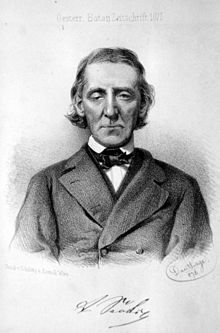Anton Sauter

Anton Eleutherius Sauter (born April 18, 1800 in Grossarl , Archdiocese of Salzburg ; † April 6, 1881 in Salzburg , Land Salzburg , Austria-Hungary ) was an Austrian botanist and medicin . Its official botanical author's abbreviation is “ Saut. "
Life
Anton Sauter was born in what was then the prince-archbishopric as the son of a carer (civil servant with judicial duties) and later a kk carer. The Sauter family soon moved to Werfen , where Anton's brother Andreas was born in 1802. Andreas later became known as a well-known forester and was head of the regional forestry department in Innsbruck. His second brother was the later famous writer Ferdinand Sauter , who died relatively early at the age of 50.
Anton's love for botany awoke early on. His favorite plant was and remained the snow rose ( Helleborus niger ), also known as the Christmas rose . In 1807 Anton's father died. The mother then moved with the children to the city of Salzburg. Sauter attended grammar school here from 1809 to 1812 and then the Collegium Rupertinum . Here began a fruitful dialogue with the botanist Franz Anton Alexander von Braune , with whom he also took lessons. His inclination to botany was also significantly promoted by Matthias Mielichhofer . At age 19 moved Sauter first in the philosophy school in Graz and soon turned (from 1820) to study medicine in Vienna, which he in 1826 with the graduation to the Dr. med. completed. He wrote his inaugural dissertation on the subject of "Attempting a geographical-botanical description of the surroundings of Vienna". His teacher was the botanist Joseph Franz von Jacquin , who is well known to this day . Soon Sauter became a member of the Regensburg Botanical Society, in whose journal he also published regularly.
From 1828 Sauter was only a secondary doctor in the St. Johanns Hospital in Salzburg Mülln , and in the same year he moved to Kitzbühel in Tyrol as a regional court doctor. In 1829 he was only in Bregenz , in 1830 he became a kk district doctor in Zell am See , then (1836) in Mittersill . In Zell am See he mainly devoted himself to research on mosses, in Mittersill on lichens and small mushrooms (published in the "Botanical Centralblatt" in 1846).
From 1839 Dr Sauter was a district doctor in Ried i. I. , 1840 in Steyr , from 1848 he worked again in Salzburg , where he stayed until his death. On August 21, 1871, he retired as a highly respected and popular doctor. For his services as a doctor he was awarded the Knight's Cross of the Franz Joseph Order .
Sauter researched the flora of the province of Salzburg and left an extensive botanical work behind. He was the first to describe many plants from the Eastern Alps . One genus and 17 species bear his name. In 1860 he was also a co-founder and from 1864 to 1874 board member of the Society for Salzburg Regional Studies .
Honors
The moss genus Sauteria Nees is named after Sauter .
The Sauterbogen in the Dreifaltigkeitsgasse in the old town on the right of the Salzach is named after him.
Works
- Attempt of a geographic-botanical description of the surroundings of Vienna (1826), printed by Anton v. Haykul
- Flora of the Duchy of Salzburg (1866–1879) Announcements of the Society for Salzburg Regional Studies No. 6 and following, published in 7 parts
- "The cryptographic flora of the north side of our Alps" - written in three parts (mosses, liverworts, lichens) published in the "Botanisches Zentralblatt" (1846)
literature
- Constantin von Wurzbach : Sauter, Anton . In: Biographisches Lexikon des Kaiserthums Oesterreich . 28th part. Kaiserlich-Königliche Hof- und Staatsdruckerei, Vienna 1874, pp. 288–290 ( digitized version ).
- F. Speta: Sauter Anton Eleutherius. In: Austrian Biographical Lexicon 1815–1950 (ÖBL). Volume 9, Verlag der Österreichischen Akademie der Wissenschaften, Vienna 1988, ISBN 3-7001-1483-4 , p. 445 f. (Direct links on p. 445 , p. 446 ).
- Paul Heiselmayer: Sauter, Anton. In: New German Biography (NDB). Volume 22, Duncker & Humblot, Berlin 2005, ISBN 3-428-11203-2 , p. 468 f. ( Digitized version ).
Web links
- Author entry and list of the described plant names for Anton Sauter at the IPNI
Individual evidence
- ↑ Baptismal Register - TFBIV | Grossarl | Salzburg, rk. Diocese | Austria | Matricula Online. Retrieved December 19, 2018 .
- ↑ Death book - STB4 | Salzburg-St. Blaise | Salzburg, rk. Diocese | Austria | Matricula Online. Retrieved December 19, 2018 .
- ↑ Lotte Burkhardt: Directory of eponymous plant names - Extended Edition. Part I and II. Botanic Garden and Botanical Museum Berlin , Freie Universität Berlin , Berlin 2018, ISBN 978-3-946292-26-5 doi: 10.3372 / epolist2018 .
| personal data | |
|---|---|
| SURNAME | Sauter, Anton |
| ALTERNATIVE NAMES | Sauter, Anton Eleutherius (full name) |
| BRIEF DESCRIPTION | Austrian botanist and physician |
| DATE OF BIRTH | April 18, 1800 |
| PLACE OF BIRTH | Grossarl , Archdiocese of Salzburg |
| DATE OF DEATH | April 6, 1881 |
| Place of death | Salzburg , State of Salzburg , Austria-Hungary |